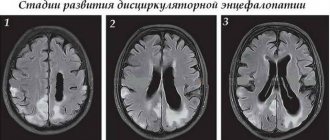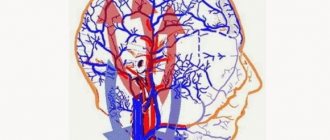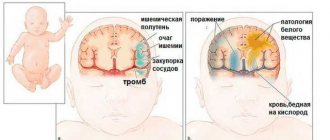Useful articles
Hepatic encephalopathy (HE) refers to pathological conditions requiring specialized medical care. Patients with the last stage (coma) require intensive care conditions. Problems arise against the background of toxic damage to the brain from toxic substances. With alcohol addiction, this type of pathology develops quite rarely, but it can be difficult to recover from it, and very often it is impossible.
Symptoms of hepatic encephalopathy ( hepatoencephalopathy) are accompanied by other manifestations of chronic alcoholism:
- personality degradation with severe impairment of intellectual abilities;
- depressive disorders;
- pathology of the peripheral nervous system;
- enzymatic-endocrine disruptions.
Diagnosis and treatment of this disease is carried out only in a hospital setting. Statistically, there is a fatal outcome in 80% of acute cases, and with late assistance. Chronic variants are more favorable for life, although they lead to limitations and disability.
Symptoms of hepatic encephalopathy
An increase in ammonia concentration in the bloodstream leads to brain dysfunction, which is accompanied by the appearance of clinical signs of pathology.
The entire symptom complex includes psychoneurological disorders, the severity of which depends on the level of toxic substances in the body. They appear:
- sleep disorder;
- inattention, memory impairment;
- apathy;
- mental dysfunction;
- lethargy and other disturbances of consciousness;
- tremor;
- cloyingly sweet, so-called “liver” odor from the mouth;
- disorder of reflex activity.
Forms
There are several forms of pathology:
- acute, which is characterized by severe lethargy, deterioration of breathing and a fixed gaze. Drowsiness can suddenly turn into psychomotor agitation with delusions and hallucinations. As it progresses, the reaction to external stimuli is completely lost, reflexes disappear, breathing is depressed, and blood pressure decreases. Acute hepatic encephalopathy lasts from two hours to several days. The risk of developing coma is very high;
- subacute, in which there is inattention, deterioration of memory, mental activity, tremors of the limbs appear, due to which a person loses the ability to hold a certain position. The handwriting also changes, the patient answers in monosyllables, the voice becomes monotonous, and speech is slurred and slow. The duration is more than a week. Periods of exacerbation are followed by remission;
- chronic type of pathology. Patients are inhibited, inadequate, apathetic, often irritated and laugh for no reason. In addition, hallucinations may occur and memory may deteriorate.
Stages
Hepatic encephalopathy goes through several stages:
- first. Symptoms include persistent malaise, headache, nausea, ringing in the ears, hiccups, bitter taste in the mouth and poor appetite. The patient is unable to concentrate, repeats words already spoken, at times does not orient himself in space, does not sleep at night, and is drowsy during the day. In addition, there is euphoria, agitation, impaired thinking, unsteadiness of gait and illegible handwriting. It is also possible that the pupil will become dilated, frequent nosebleeds and hematomas on the skin;
- on the second, patients are sharply inhibited, apathetic, drowsy and trying to escape somewhere. In addition, delirium, hallucinations, fainting, disorientation in place and space are noted. A person experiences limb spasms and facial tics. Breathing becomes frequent, jaundice appears, and a “liver” odor is felt from the mouth;
- the third stage is characterized by depression of consciousness, convulsions, short periods of excitement, which are accompanied by hallucinations. When diagnosed, a decrease in the size of the liver, increased jaundice and lack of facial expressions are noted. A characteristic clinical sign is hemorrhagic diathesis against the background of increased bleeding and dysfunction of the coagulation system.
Course, complaints and symptoms of hepatic encephalopathy in alcoholism
PE can occur in acute and chronic forms. The first develops over several hours or days. The second option is characterized by a slow course, sometimes lasting more than one year.
Stages of hepatic encephalopathy:
- Initial changes (compensation). Patients report sleep disorders, increased unmotivated irritability, attacks of apathy, and general loss of strength. Upon examination, the doctor determines the yellowness of the mucous membranes, and less often - the skin.
- Clinical manifestations (subcompensation). Mental problems are getting worse. They are accompanied by pronounced aggressiveness. Muscle (flapping) twitching during tension is detected - asterixis. The amplitude of these painful movements is wide and is observed both in the limbs and in the muscles of the neck and torso. Damage to the thermoregulation center results in periodic and unreasonable increases and decreases in temperature. There are violations of intellectual abilities. The patient becomes forgetful, cannot read and write, looks around him absent-mindedly and uncertainly. During certain periods, gaze fixation is observed. A specific sweetish (liver) odor emanating from the patient indicates a metabolic disorder.
- Terminal (decompensation). In this phase of the disease, disturbances of consciousness develop. Among the main symptoms is disorientation, the aggressiveness of which gradually reaches a soporous status. It is characterized by suppression of conscious functions, but preservation of reflexes. As a result of stupor, coma is formed - a completely unconscious state with complete inhibition of the reflex activity of the body, which is preceded by a convulsive syndrome. It is at this moment that most patients die.
Etiology
Depending on the underlying cause of the pathology, several types of hepatic encephalopathy are distinguished. It may be related to:
- intoxication. Neurotoxins can enter the bloodstream due to intestinal dysbiosis or abuse of protein foods;
- acutely increasing liver failure. Among the predisposing factors, it is worth highlighting viral hepatitis, alcoholic damage to the gland, cancer and other diseases accompanied by the death of hepatocytes (liver cells);
- cirrhosis. The main cause of encephalopathy in this case is the replacement of healthy organ tissue with connective tissue, which leads to the formation of scars and liver dysfunction, including detoxification.
The triggering point for the development of encephalopathy can also be:
- alcoholism;
- massive bleeding;
- chronic intestinal dysfunction in the form of constipation;
- infectious process in the body;
- peritonitis.
The pathogenesis of hepatic encephalopathy is based on changes in the electrolyte and protein composition of the blood, an increase in the level of ammonia, phenols, and fatty acids in the body. As a result, the brain does not receive enough oxygen and nutrients, and is exposed to toxins, which damages nerve cells, increases intracranial pressure, and shows signs of cerebral edema.
Diagnostics
The diagnosis is confirmed based on the results of a complete examination of the patient. It begins with a history taking, after which the doctor determines a range of diagnostic techniques that can confirm hepatic encephalopathy. For this purpose, laboratory tests, instrumental studies are prescribed, and the patient’s neuropsychic status is also assessed.
Anamnesis
The principle of collecting anamnesis is to sequentially ask the patient about:
- time of appearance of the first signs of the disease;
- rate of symptom progression;
- past and chronic diseases;
- allergic heredity;
- lifestyle (diet, bad habits);
- professions;
- taking hepatotoxic drugs.
A detailed medical history allows one to suspect the disease and suggest the degree of liver damage, as well as the severity of psycho-emotional disorders.
Laboratory methods
To assess the severity of intoxication and the degree of liver dysfunction, laboratory tests are necessary. These include:
- general clinical blood test, which records an increased level of leukocytes, neutrophils, a decrease in hemoglobin, platelets, as well as an accelerated ESR;
- urine examination reveals casts, red blood cells, protein, bilirubin and urobilin in the material;
- biochemistry. The first laboratory harbinger of liver pathology is an increase in bilirubin, ammonia and transaminases (ALT, AST). In addition, a decrease in protein levels and changes in the amount of electrolytes are recorded;
- coagulogram. A late symptom of the disease is increased bleeding, which is caused by a deficiency of coagulation factors against the background of functional liver failure and low protein levels.
Instrumental diagnostics
To visualize the liver, assess its size, structure and density, an instrumental examination is necessary. Non-invasive techniques include ultrasound of the hepatobiliary tract (gland, biliary tract) and surrounding organs. Computer and magnetic resonance imaging are also considered informative.
Confirmation of liver failure requires puncture analysis (biopsy) or elastography. The disease must be differentiated from extrahepatic pathologies, such as acute disruption of local blood flow and rupture of an aneurysm, as well as infectious pathologies, metabolic disorders and direct drug effects on the central nervous system.
Psychometric tests
To assess brain damage, as well as the severity of its dysfunction, electroencephalography is required. Hepatic encephalopathy of the second stage is manifested by a sharp inhibition of the rhythm, an increase in the height of the waves and the appearance of their constant forms (theta-, delta-).
An objective study of the neuropsychic state includes registration of a “flapping tremor”. It is characteristic of the second and third stages. Its development is based on a disorder in the connection between the musculoskeletal system and the brain against the backdrop of a slowdown in the movement of nerve impulses. As a result, the patient is unable to maintain a certain position. To identify this sign of illness, it is enough to ask the person to raise his outstretched arms in front of him and fix them in this position. The test is considered positive when flapping movements are recorded in the wrist joints. This manifestation of pathology can change its character depending on the patient’s physical activity. Thus, in a fixed position, the tremor intensifies, and when moving the hands, it weakens.
In addition, diagnostic tests such as:
- arithmetic;
- linear;
- numerical. To do this, the patient is asked to count to 25, after which the number of errors and the time required to complete the task are assessed;
- handwriting analysis;
- copying lines.
Diagnosis of hepatoencephalopathy
If the damage to the liver and brain is alcoholic, the doctor is interested in:
- symptomatic picture;
- establishing the severity of the disease;
- stage of the process.
Based on the data obtained, during a survey and examination, the doctor prescribes additional types of diagnosis of hepatic ecephalopathy.
These include:
- A detailed clinical blood test with determination of the content of erythrocytes, leukocytes, hemoglobin, platelets.
- Biochemistry data with liver tests, bilirubin, alkaline phosphatase, gamma globulin transferase.
- Ultrasound of the parenchymal organs of the abdominal cavity. The specialist is especially interested in the condition of the liver, pancreas, and kidneys.
- Computed tomography is the most informative method of x-ray diagnostics.
- MRI in doubtful cases, as an additional diagnostic method.
- Needle biopsy as the most accurate option for differential diagnosis.
Hepatic coma
Separately, it should be said about such a serious complication of liver failure as coma. It develops against the background of a pronounced disorder of the brain, which is accompanied by depression of consciousness. Despite treatment, in most cases the patient dies.
The mechanism of hepatic coma is based on metabolic disorders and cerebral circulatory disorders, causing oxygen starvation and tissue swelling.
Nerve cells are affected by ammonia, phenols, and fatty acids.
Symptoms of hepatic coma
The severity of symptoms depends on the stage of the pathological process:
- the first stage of development is characterized by a lack of consciousness with a preserved response to pain. Convulsions, dilated pupils, spontaneous urination and defecation are also observed;
- in deep coma there are no reactions to stimuli, complete paralysis is diagnosed, convulsions with respiratory arrest and a decrease in blood pressure are possible.
In addition, symptoms of liver damage are observed. They are represented by jaundice, hemorrhagic syndrome, tachycardia and hyperthermia.
Diagnosis and emergency care for hepatic coma
The diagnosis is established after a complete examination:
- collecting anamnesis from relatives;
- examination of the patient;
- assessment of neurological status;
- laboratory tests of blood, urine and cerebrospinal fluid;
- electroencephalograms;
- Brain MRI;
- Ultrasound of the liver;
- elastography.
The patient should be treated in the intensive care unit. The emergency treatment complex includes:
- identification and cessation of exposure to a provoking factor (infection, toxins);
- ECG, monitoring intracranial hypertension, oxygen levels and blood pressure;
- tracheal intubation and mechanical ventilation;
- narcotic analgesics, hypnotics to reduce agitation and relieve seizures;
- transfusions of plasma and red blood cells;
- infusion therapy (decongestant, metabolic, neuroprotective, vascular);
- antibiotics, vikasol, stimulants of enzymatic activity of hepatocytes (liver cells);
- extracorporeal detoxification methods (hemodialysis, plasmapheresis).
Survival rate with hepatic coma does not exceed 20%.
Treatment of hepatic encephalopathy caused by alcohol intoxication
Therapy for PE is quite complex. The correct choice of treatment tactics is based on identifying and eliminating the main cause of the pathology, the form and stage of the disease.
The general therapeutic course includes:
- Diet therapy - food intake with protein restriction to the level of 1 gram per kilogram of the patient’s weight per day, limiting table salt.
- Measures to cleanse the intestines - enemas twice a day, preparations containing lactulose, ornithine and zinc sulfate (to remove toxic ammonia due to the onset of an interaction reaction).
- Antimicrobial therapy - injections of broad-spectrum antibiotics, as well as drugs that prevent the development of bacteria in the intestines.
- Medicines that suppress mental arousal processes. For this purpose, the use of haloperidol is recommended. Tranquilizers, especially those from the benzodiazepine group, are not indicated due to the risk of possible complications.
In case of development of acute hepatic coma caused by ethanol poisoning, the treatment regimen is supplemented with specific therapy.
It additionally includes:
- prescription of diuretics (combat cerebral edema);
- stopping bleeding;
- relief of manifestations of aspiration pneumonia (complication);
- elimination of symptoms of pancreatitis.
All measures to cure PE must be carried out in intensive care. A positive prognosis can only be discussed in the case of a chronic form of the disease. The survival rate of patients with concomitant liver cirrhosis is an order of magnitude lower. The final outcome of the acute form depends on the stage at which resuscitation measures are started. In the early phase, survival rate is about 35%. The terminal option is the saddest. Almost 80% of patients die. Prevention of hepatic encephalopathy caused by alcohol abuse is to maintain a sober lifestyle.
The text was checked by expert doctors:
Head of the socio-psychological service of the Alkoklinik MC, psychologist Yu.P. Baranova, L.A. Serova, a psychiatrist-narcologist.
CAN'T FIND THE ANSWER?
Consult a specialist
Or call: +7 (495) 744-85-28
Call! We work around the clock!
Treatment of hepatic encephalopathy
The first step is to establish and eliminate the cause of liver damage. Then further treatment tactics are determined. Thus, diet therapy, bowel cleansing and drug support are recommended.
Medications
Treatment of hepatic encephalopathy should be carried out using a number of medications, such as:
- antibacterial medicine to prevent infectious complications and combat existing pathogens;
- sorbents, which are necessary to prevent the absorption of toxins in the intestines, increasing intoxication and aggravating the course of encephalopathy. According to indications, enemas are prescribed;
- detoxification solutions for intravenous administration (Reosorbilact);
- antiviral (ribavirin, alpha-interferon - Viferon) for infectious hepatitis;
- metabolic to maintain the functions of neurons and normalize their nutrition;
- drug for reducing ammonia lactulose, hepa-merz and hepasol. The latter is also used for parenteral nutrition and replenishment of amino acid deficiencies;
- flumazenil. This medicine is prescribed to reduce the inhibition of brain function.
Surgical methods
Depending on the cause and course of the disease, the following may be used:
- X-ray endovascular techniques;
- extracorporeal (plasmapheresis, separation). They are necessary to restore the functioning of hepatocytes (liver cells) and reduce intoxication;
- Gland transplantation is the most effective treatment method, however, if the causative factor persists, a relapse of the disease is possible. There are two types of surgery. The doctor can completely remove the patient’s affected organ and “transplant” a new one in its place. The second method involves preserving the patient’s liver and additionally “planting” a donor one.
Diet therapy
Basic principles of dietary nutrition:
- limiting protein intake to 20 g per day (at stages 3 and 4) and to 50 g at the initial stage of encephalopathy development. This is necessary to reduce the level of ammonia in the bloodstream, which has a toxic effect on the brain;
- strict salt control;
- protein foods of plant origin are recommended;
- meals should be fractional (meals every two hours in small portions);
- per day you need to drink at least 1.5 liters of fluid under strict control of diuresis (to prevent the increase in cerebral edema).
The nutritional diet can be expanded as the patient feels better, laboratory parameters and neuropsychic status improve. Energy needs are partially covered by intravenous administration of glucose solution.
What is the basis of hepatic encephalopathy?
Scientists still cannot say exactly why hepatic encephalopathy develops. There are three theories explaining why brain activity is disrupted when liver tissue dies, and each of them has convincing evidence:
- Toxic (ammonia) theory. She says that brain function deteriorates due to toxins (primarily ammonia and protein decay products), formed largely in the large intestine, as well as in the muscles, in the small intestine and in the liver - when proteins are broken down in it . The body always tries to maintain a balance between the formation and neutralization of ammonia, but if this does not happen, the toxins flow through the portal vein to the liver. There, ammonia would have to enter a cycle of reactions called the ornithine cycle to form urea. But since the liver cells are damaged, the rate of neutralization of toxins and ammonia is greatly slowed down. They, together with those substances that bypassed the liver and went directly into the inferior vena cava, are toxic substances to the brain. The situation can be improved by the “correct” amino acids, which neutralize ammonia “bypassing” the ornithine cycle - and along the path of the formation of glutamine from it. These are arginine, glutamic acid, ornithine and aspartate. They convert ammonia into glutamine, which is non-toxic to the brain.
- False neurotransmitter theory. She says that with liver failure, protein decay in the large intestine increases. The body tries to use some amino acids - those with a branched chain structure (leucine, valine, isoleucine) - as energy. As a result, aromatic amino acids (phenylalanine, tyrosine, tryptophan) enter the blood, which should normally undergo metabolism in the liver. They reach the brain and stimulate the formation of transmitting substances that should not be there (false neurotransmitters). This inhibits the enzyme system that should convert tyrosine into dioxyphenylalanine (from which dopamine and norepinephrine are obtained). Phenylethylamine, octopannine, and thyronine, which inhibit its functioning, also accumulate in the brain. This dictates the need to stop the intake of protein nutrition, replacing it with the introduction of only balanced mixtures consisting of the right amino acids.
- The neuroglia hypothesis (this is the name of the tissue that is auxiliary in the brain). She says that toxins that appear during liver failure, as well as an imbalance of amino acids, lead to swelling of neuroglia and disruption of its functioning. But if in cirrhosis or fibrosis of the liver compounds toxic to the brain are formed in the intestines, then in acute hepatitis caused by various viruses they are products of liver destruction.
Prognosis and prevention
The prognosis depends on the underlying cause and duration of the disease. Encephalopathy associated with acute liver dysfunction leads to death in 85% of cases. In case of chronic disease, complex treatment can significantly improve the patient’s quality of life by 30-75%.
As for prevention, it consists of preventing liver damage. It is necessary to avoid casual sex, strictly control the intake of medications, give up alcohol and normalize the nutritional diet.
It is important to remember that the traditional approach to treatment is absolutely ineffective for hepatic encephalopathy. It leads to the progression of the disease and accelerates the onset of coma.











